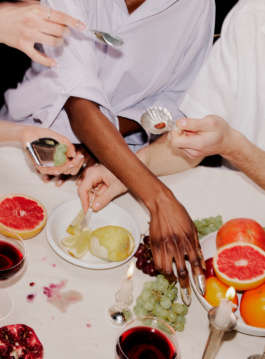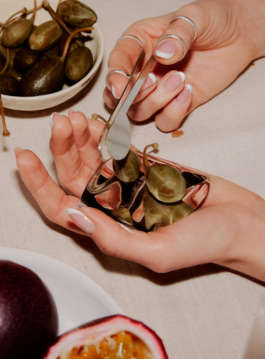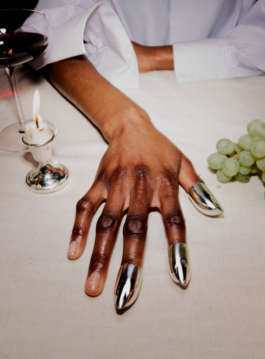



© Lilli Malou Weinhold, Jan Buschmann, Marvin Hillebrand
COLLECTIBLE In-Depth
Lilli Malou Weinhold
April 2024
This series, COLLECTIBLE In-Depth, unveils the backstage of contemporary creation. Tackling various topics from personal designer processes to the position of collectible design on the global design market, COLLECTIBLE In-Depth offers different views to suit all tastes. Today we speak with Lilli Malou Weinhold.
COLLECTIBLE: How do you understand collectible design’s unique story from your concept to a piece someone lives with (and perhaps forms an emotional connection to)?
Lilli Malou Weinhold: My goal in designing objects is to nurture an emotional connection between users and objects. It's not essential for users to echo my emotions; what counts is their sense of being drawn to, touched by, and accompanied by the objects—design's most beautiful aspect. The origin of this attraction to specific objects is challenging to express but universally acknowledged, reminiscent of feelings of home and security. This makes it a deeply personal sentiment, best cherished in quiet reflection.
C: Where do you take your inspiration from?
LMW: My project "Dig In" delves into the rich history of cutlery, particularly during the 16th-18th centuries, while analyzing table manners and customs from the Stone Age to today's developments and traditions. Across diverse cultures, the connection between food and utensils mirrors societal changes, with many traditions fading into memory over time. Studying the origins of European dining customs, I incorporate fragments of natural materials like shells and stones into my work. By honoring tradition while envisioning its future relevance, I strive to preserve its legacy.
C: Are you more result or process oriented?
LMW: I'm more process-oriented. When I work on new objects, I let myself drift and first acquaint myself with the material and its personality. I always trust my gut feeling, and the design process unfolds very intuitively. Through various experiments and visualizations in my head, I approach the final design. But even when the finished object is presented, a new phase of the project begins, which I find just as exciting as the exploration phase. Through distributing objects and exchanging ideas with others, the project continuously evolves and is further shaped and enriched.
C: Can you briefly describe your process?
LMW: Most of my exhibited objects are made from silver sheets, meticulously shaped, filed, and riveted, echoing ancient craftsmanship, adding to their mystique. The labor-intensive shell spoon is fashioned with hammer and punches through chiseling. In contrast, the fingertip attachments start as wax models, cast via vacuum pressure, then refined by hand. Crafting with silver is a meticulous journey, its true beauty revealed in the final stages when polished and cleaned, rewarding one's effort. Working by hand in the workshop is a blend of intuition and meditation, making it worthwhile.
C: How do sustainability-related questions influence your practice?
LMW: For me, sustainability goes beyond material choices or recycling. It's about cultivating a strong bond between users and objects, ensuring longevity. Emotional connections encourage us to repair, care for, and pass on possessions. It's vital to initiate discussions and thoughts shaping future lifestyles, rather than solely focusing on new materials and objects. With most of our needs met, design should engage users in dialogue about potential future changes and how we want to shape them.

© Lilli Malou Weinhold, Jan Buschmann, Marvin Hillebrand

© Lilli Malou Weinhold, Jan Buschmann, Marvin Hillebrand

© Lilli Malou Weinhold, Jan Buschmann, Marvin Hillebrand
COLLECTIBLE In-Depth
Lilli Malou Weinhold
April 2024
This series, COLLECTIBLE In-Depth, unveils the backstage of contemporary creation. Tackling various topics from personal designer processes to the position of collectible design on the global design market, COLLECTIBLE In-Depth offers different views to suit all tastes. Today we speak with Lilli Malou Weinhold.
COLLECTIBLE: How do you understand collectible design’s unique story from your concept to a piece someone lives with (and perhaps forms an emotional connection to)?
Lilli Malou Weinhold: My goal in designing objects is to nurture an emotional connection between users and objects. It's not essential for users to echo my emotions; what counts is their sense of being drawn to, touched by, and accompanied by the objects—design's most beautiful aspect. The origin of this attraction to specific objects is challenging to express but universally acknowledged, reminiscent of feelings of home and security. This makes it a deeply personal sentiment, best cherished in quiet reflection.
C: Where do you take your inspiration from?
LMW: My project "Dig In" delves into the rich history of cutlery, particularly during the 16th-18th centuries, while analyzing table manners and customs from the Stone Age to today's developments and traditions. Across diverse cultures, the connection between food and utensils mirrors societal changes, with many traditions fading into memory over time. Studying the origins of European dining customs, I incorporate fragments of natural materials like shells and stones into my work. By honoring tradition while envisioning its future relevance, I strive to preserve its legacy.
C: Are you more result or process oriented?
LMW: I'm more process-oriented. When I work on new objects, I let myself drift and first acquaint myself with the material and its personality. I always trust my gut feeling, and the design process unfolds very intuitively. Through various experiments and visualizations in my head, I approach the final design. But even when the finished object is presented, a new phase of the project begins, which I find just as exciting as the exploration phase. Through distributing objects and exchanging ideas with others, the project continuously evolves and is further shaped and enriched.
C: Can you briefly describe your process?
LMW: Most of my exhibited objects are made from silver sheets, meticulously shaped, filed, and riveted, echoing ancient craftsmanship, adding to their mystique. The labor-intensive shell spoon is fashioned with hammer and punches through chiseling. In contrast, the fingertip attachments start as wax models, cast via vacuum pressure, then refined by hand. Crafting with silver is a meticulous journey, its true beauty revealed in the final stages when polished and cleaned, rewarding one's effort. Working by hand in the workshop is a blend of intuition and meditation, making it worthwhile.
C: How do sustainability-related questions influence your practice?
LMW: For me, sustainability goes beyond material choices or recycling. It's about cultivating a strong bond between users and objects, ensuring longevity. Emotional connections encourage us to repair, care for, and pass on possessions. It's vital to initiate discussions and thoughts shaping future lifestyles, rather than solely focusing on new materials and objects. With most of our needs met, design should engage users in dialogue about potential future changes and how we want to shape them.

© Lilli Malou Weinhold, Jan Buschmann, Marvin Hillebrand

© Lilli Malou Weinhold, Jan Buschmann, Marvin Hillebrand
Contact
info@collectible.design
VIP PORTAL
EXHIBITOR PORTAL
PRIVACY POLICY
© 2025 Collectible
Contact
info@collectible.design
VIP PORTAL
EXHIBITOR PORTAL
PRIVACY POLICY
© 2025 Collectible